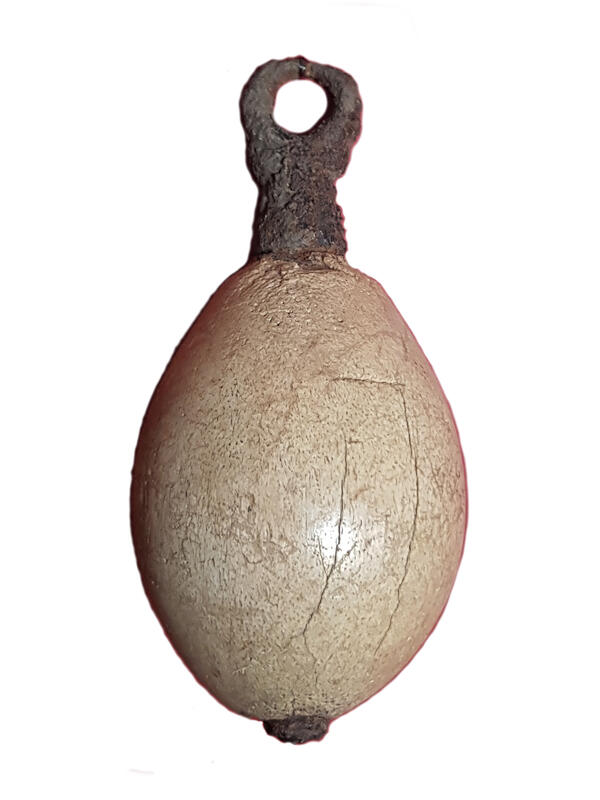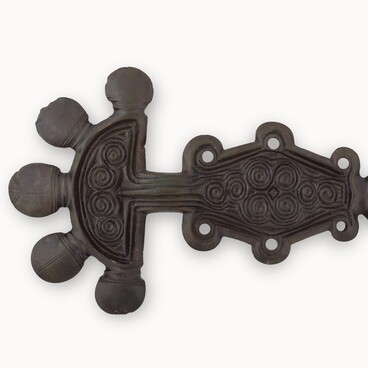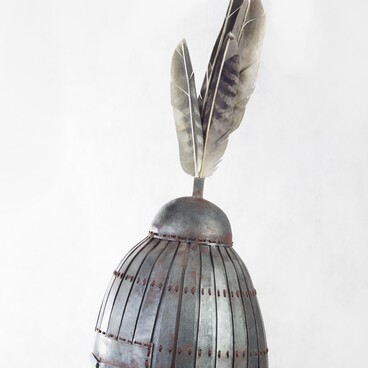The Kursk Regional Museum of Archaeology holds a collection of ancient weapons, which are rare finds during archaeological excavations. One such artifact was found by the archaeologist and local historian Gennady Yuryevich Starodubtsev in 1994 while studying mound No. 76 at the archaeological monument “Gochevo. Burial mound 1”.
The weapon was an egg-shaped bone flail with a slot along the axis, into which an iron rod with a noose on one end and a rivet on the other was inserted. The weapon was near the right leg of the buried woman. A white metal wire ring, 2 cm in diameter, and a white metal plate ring with overlapping ends were also found there.
It is noteworthy that a similar bone flail ball was found when the archaeological excavations of the Gochevsky burial mound led by the outstanding archaeologist Dmitry Yakovlevich Samokvasov started in 1909. And, interestingly enough, it was also found in a woman’s burial. Based on the peculiarities of the burial ritual (the deceased were at the level of the ancient daylight surface, that is, at a layer which was once lit by the sun and was the surface on which life progressed), experts date the burial from the mound to the late 11th — early 12th centuries.
The flail is dated between the 10th to the 13th century. The very type of this striking weapon is well known: flails were part of the Khazar weaponry since the early 8th century. There are two types of flails based on the way the flail heads are suspended: the balls with an eye and the balls with a through slot. The flail balls with a through slot were simply suspended on a strap and could be used by both riders and foot soldiers. The balls with an eye were attached with a strap to a wooden handle. Such flails were used only by horsemen. The most widespread type among them is the ovoid bone flail ball with an iron rod inside. The weapon discovered in the Gochevsky mound belongs to this type. It was possible to use it effectively only against a poorly armed enemy.
The weapon was an egg-shaped bone flail with a slot along the axis, into which an iron rod with a noose on one end and a rivet on the other was inserted. The weapon was near the right leg of the buried woman. A white metal wire ring, 2 cm in diameter, and a white metal plate ring with overlapping ends were also found there.
It is noteworthy that a similar bone flail ball was found when the archaeological excavations of the Gochevsky burial mound led by the outstanding archaeologist Dmitry Yakovlevich Samokvasov started in 1909. And, interestingly enough, it was also found in a woman’s burial. Based on the peculiarities of the burial ritual (the deceased were at the level of the ancient daylight surface, that is, at a layer which was once lit by the sun and was the surface on which life progressed), experts date the burial from the mound to the late 11th — early 12th centuries.
The flail is dated between the 10th to the 13th century. The very type of this striking weapon is well known: flails were part of the Khazar weaponry since the early 8th century. There are two types of flails based on the way the flail heads are suspended: the balls with an eye and the balls with a through slot. The flail balls with a through slot were simply suspended on a strap and could be used by both riders and foot soldiers. The balls with an eye were attached with a strap to a wooden handle. Such flails were used only by horsemen. The most widespread type among them is the ovoid bone flail ball with an iron rod inside. The weapon discovered in the Gochevsky mound belongs to this type. It was possible to use it effectively only against a poorly armed enemy.



